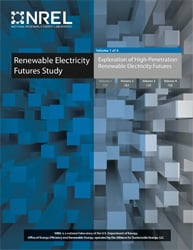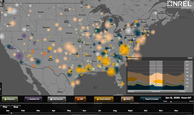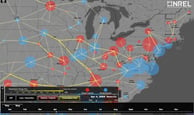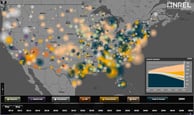Renewable Electricity Futures Study
The Renewable Electricity Futures Study (RE Futures) is an investigation of the extent to which renewable energy supply can meet the electricity demands of the continental United States over the next several decades.
This study explores the implications and challenges of very high renewable electricity generation levels—from 30% up to 90%, focusing on 80%, of all U.S. electricity generation—in 2050. At such high levels of renewable electricity generation, the unique characteristics of some renewable resources, specifically geographical distribution and variability and uncertainty in output, pose challenges to the operability of the nation's electric system.
Key Findings
- Renewable electricity generation from technologies that are commercially available
today, in combination with a more flexible electric system, is more than adequate
to supply 80% of total U.S. electricity generation in 2050 while meeting electricity
demand on an hourly basis in every region of the country.
- Increased electric system flexibility, needed to enable electricity supply and demand
balance with high levels of renewable generation, can come from a portfolio of supply-
and demand-side options, including flexible conventional generation, grid storage,
new transmission, more responsive loads, and changes in power system operations.
- The abundance and diversity of U.S. renewable energy resources can support multiple
combinations of renewable technologies that result in deep reductions in electric
sector greenhouse gas emissions and water use. The direct incremental cost associated
with high renewable generation is comparable to published cost estimates of other
clean energy scenarios. Improvement in the cost and performance of renewable technologies
is the most impactful lever for reducing this incremental cost.
- RE Futures provides initial answers to important questions about the integration of high penetrations of renewable electricity technologies from a national perspective, focusing on key technical implications. The study explores electricity grid integration using models with unprecedented geographic and time resolution for the contiguous United States to assess whether the U.S. power system can supply electricity to meet customer demand on an hourly basis with high levels of renewable electricity, including variable wind and solar generation.
RE Futures, funded by the U.S. Department of Energy's Office of Energy Efficiency and Renewable Energy, is a collaboration with more than 110 contributors from 35 organizations including national laboratories, industry, universities, and non-governmental organizations.
As the most comprehensive analysis of high-penetration renewable electricity of the continental United States to date, the study can inform broader discussion of the evolution of the electric system and electricity markets toward clean systems. RE Futures results indicate that renewable generation could play a more significant role in the U.S. electricity system than previously thought and that further work is warranted to investigate this clean generation pathway.
Publications
Renewable Electricity Futures Report
Volume 1: Exploration of High-Penetration Renewable Electricity Futures (includes Executive Summary)
Volume 2: Renewable Electricity Generation and Storage Technologies
Volume 3: End-Use Electricity Demand
Volume 4: Bulk Electric Power Systems: Operations and Transmission Planning
Journal Articles and Reports

Operational Analysis of the Eastern Interconnection at Very High Renewable Penetrations, NREL Technical Report (2018)
Renewable Electricity Futures: Operational Analysis of the Western Interconnection at Very High Renewable Penetrations, NREL Technical Report (2015)
Renewable Electricity Futures for the United States, IEEE Transactions on Sustainable Energy (2014)
Envisioning a Renewable Electricity Future for the United States, Energy (2014)
Implications of High Renewable Electricity Penetration in the U.S. for Water Use, Greenhouse Gas Emissions, Land-Use, and Materials Supply, Applied Energy (2014)
Meta-Analysis of High-Penetration Renewable Energy Scenarios, Renewable and Sustainable Energy Reviews (2014)
Decision-Making for High Renewable Electricity Futures in the United States, Energy Strategy Reviews (2014)
Projecting Electricity Demand in 2050, PNNL Technical Report (2014)
Accelerating the Global Transformation to 21st Century Power Systems, The Electricity Journal (2013)
Bright Future: Solar Power as a Major Contributor to the U.S. Grid, IEEE Power and Energy Magazine (2013)
Data and Tools
RE Futures Visualizations
These visualizations are based on RE Futures modeling and represent the transformation of the U.S. electric system to a high renewable system from 2010 to 2050 and the hourly operation and transmission flow of that system in 2050.

Hourly Operation in 2050
(Compare to Baseline Projections)

Power Flow in 2050
(Compare to Baseline Projections)
Energy Models Used in the Study
Regional Energy Deployment System (ReEDS)
Technology Cost and Performance Assumptions Used in Scenario Analysis
Transparent Cost Database/Open Energy Information
Includes cost (capital and operating) and capacity factor assumptions for renewable
generation technologies used for baseline, incremental technology improvement, and
evolutionary technology improvement scenarios, along with other published and DOE
program estimates for these technologies
Scenario Results
RE Futures Volume 1 Figure Data
Geographical Distribution of Renewable Technology Capacity in 2050
Demands calculation
In the News
Slashing Fossil Fuel Consumption Comes with a Price, All Things Considered (2013)
Six Myths about Renewable Energy: The Impact on Jobs and Other Assumptions That Don't Hold Up Anymore, Wall Street Journal (2013)
Report Explores Renewable Electricity Futures, Windpower Engineering and Development (2012)
U.S. Renewable Electricity Future Is Within Reach , The Union of Concerned Scientists (2012)
80% Clean, Renewable Energy by 2050: More Than Possible, But Need More Political Will (and Public Demand), Clean Technica (2012)
Thinking Big: 80 Percent Renewables Is Possible by 2050, Care 2 Make a Difference (2012)
Share
Last Updated Nov. 10, 2025

